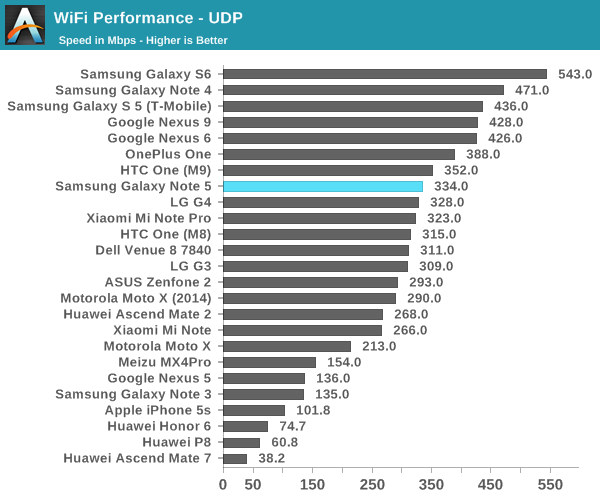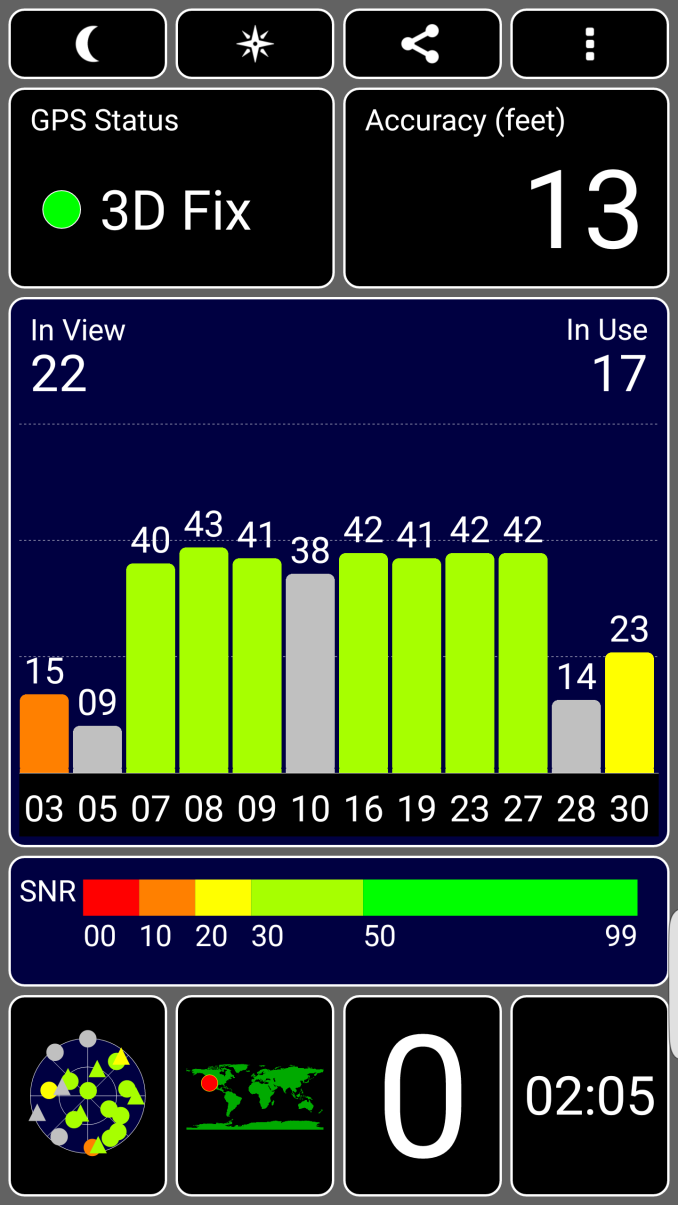The Samsung Galaxy Note5 and Galaxy S6 edge+ Review
by Joshua Ho on October 2, 2015 8:00 AM ESTVideo Performance
Now that we’ve taken a look at still image performance, we can look at video performance. For the most part these results should be similar to still image performance, but we’re looking at encoder efficiency, good sound recording, and effective stabilization. The Galaxy Note5 and Galaxy S6 edge+ both have OIS in order to improve stability in video recording, and for the most part the feature set of both is similar to the Galaxy S6 when it comes to video.
Galaxy Note5
Galaxy S6
Galaxy Note5
iPhone 6
For 1080p30, Samsung has elected to use 17Mbps High Profile H.264, along with a 256 Kbps stereo audio channel encoded with AAC. If this sounds familiar, it's because this is shared with the Galaxy S6. Quality is indistinguishable. Unfortunately, it seems the same sort of jerky OIS reset effect is still present although it isn't too obvious in these videos.
Galaxy S6
iPhone 6
It probably goes without saying, but once again the Galaxy Note5 shares the same video encode settings with the Galaxy S6, with 28 Mbps High Profile H.264 encoding for 1080p60 video. In these samples you can more clearly see the issues that come with OIS in video, which is that there are instances of jerky video movement when it should be relatively smooth, even if it's shaky. The only real difference between the Galaxy S6 and Note5/S6 edge+ is that the Note5 removes a bit of the yellow tinge/saturation boost that we see in the Galaxy S6. There's otherwise relatively little to comment on here.
Once again, not much is different when comparing the Galaxy Note5 and Galaxy S6 edge+ to the Galaxy S6 other than saturation differences in some cases. The same encoder settings are also used for 48 Mbps HP H.264 with 256 Kbps AAC stereo audio.
Galaxy Note5
Galaxy S6
Galaxy Note5
iPhone 6
If you're able to read the trend, you can probably guess that the Galaxy Note5 and S6 edge+ are going to share the same encode profiles as the Galaxy S6, which is 48Mbps HP H.264. Once again, quality is effectively identical here and the changes are slim to none. This unfortunately means that the iPhone 6 still leads here as the quality of the slow motion video on the Galaxy Note5 and Galaxy S6 line weren't much good to begin with.
WiFi Performance
For the most part, it probably goes without saying that one of the cornerstones of a smartphone or phablet is mobile data. After all, without mobile data you’re effectively limited by whatever WiFi hotspot you can find, which is often limited in range. Comparatively speaking, mobile data is generally more versatile. However, in the case of most mobile devices WiFi is often used at home in order to utilize a normally lower-latency connection with generally higher throughput. Given the reality of data caps, WiFi is also often needed for things like app updates, video streaming, and possibly music streaming. As a result, poor WiFi can sink a phone. In order to try and get a basic measure of performance, we look at peak UDP bandwidth using iPerf. In the case of the Galaxy Note 5, Samsung has upgraded the WiFi chipset from the BCM4358 used in the Galaxy S6 to Broadcom’s BCM4359. This is supposed to allow connections to 2.4 and 5 GHz WiFi simultaneously, but in practice it doesn’t really look like it’s used outside of potentially faster scanning.

Interestingly, I was unable to get the download speeds that I was expecting from a 2x2 802.11ac WiFi solution despite using 5 GHz. It's possible that this is due to interference as I can't isolate the system from other WiFi hotspots in the area, but in my experience I never had any real issues with WiFi that I could notice. Reception doesn't seem to be any better or worse than other devices I've tried in recent memory.
GNSS Performance
GNSS is often critical to a mobile device these days, as a number of applications rely on highly accurate location in order to work properly. Probably the most obvious case here is going to be GPS navigation, but things like lost/stolen device location, geofencing, location-based check-ins, and other applications are all generally quite reliant on accurate location that only GNSS systems can provide. In the case of the Galaxy Note5 and Galaxy S6 edge+, we see that the GNSS module is shared with the Galaxy S6 for the Shannon modem variants as a BCM4773 GNSS location hub is present within the system.
In practice, I didn’t find much wrong with this solution. Time to first lock without any assistance data took about 30 seconds, and at the 46 second mark the maximum possible accuracy was achieved. With assistance data, a position fix was reported within 5 seconds of launching the GPS Test app. Overall, I doubt anyone will face any real problems dealing with GPS/GNSS location on these devices.











225 Comments
View All Comments
Sailor23M - Saturday, October 3, 2015 - link
Well said.just4U - Wednesday, October 7, 2015 - link
While not a fanboy.. (it's a phone for (censored) sake..) I do use Samsung phones pretty much exclusively these days simply because I am familiar with them and I've yet to see a company make one I like better.. That being said.. I am a long reader and commenter here as well.. and I certainly don't see any hate-on for any company or love-in for that matter.Occasionally some reviewers may know they have a certain amount of bias for some companies and may go overboard in trying to be fair ..coming across as to critical.. but that's pretty rare.
Tech_guy - Friday, October 2, 2015 - link
Apple is designing extremely fast chips these days with amazing performance combined with iOS 9, it's hard to deny that iPhone 6s is the leader right now, by a LONG shot.nerd1 - Friday, October 2, 2015 - link
Only thing 6s is better is better singlethread performance and GPU. 7420 still has better multithread performance (which android does use, says anandtech article!) and comes with better and larger display, smaller and lighter device, and true wacom pen and better camera.I just don't get it how 6s is "the leader" as it lacks in many division compared to now old GS6.
Tech_guy - Friday, October 2, 2015 - link
It's not about the quanity of your cores but their quality. Just look at how Intel obliterates AMD because of their stronger IPC in each core. It's not of the same Apple has set the single core benchmark so high that others will HAVE to focus on single core performance. What some real world comparisons of iPhone 6s vs Note 5, anytime it's a larger app like a game or something the iPhone 6s just destroys those weak cores in the Exynos 7422.thedons1983 - Sunday, October 18, 2015 - link
What a moronic comment! If your assertion were actually true, then literally everyone would buy an iPhone. They don't, however, because not everyone wants to suck on apples tainted teat. Their software is utter garbage, and the only reason they close it down so much, is because they know that it would simply break otherwise. IOS is woeful, as is OS-x, hence why user rates are so incredibly low. Even windows 8, which lots of people hated, has user numbers that OS-X could only dream of. Primarily, it's because windows is just better. Android beats IOS in almost every respect, and the only people that can't comprehend that, are idiot fanboys like you. You are actually, and truly, pathetic.Sailor23M - Saturday, October 3, 2015 - link
I have been a regular reader since 2003/04 time period - so a good 10+ years. Although I am an Apple user I do feel the site has progressively increased their bias/tilt towards Apple. If its true that "Galaxy Phones are pushing 4 times more pixels" then this should have been mentioned in the review.Kuzi - Saturday, October 3, 2015 - link
Galaxy S6/Edge/Note 5 resolution:2560x1440= 3686400 pixels
IPhone 6/6S resolution:
1334x750= 100500 pixels
The Galaxy phones are pushing 3.68 times more pixels than iPhone 6 & 6S.
Peichen - Monday, October 5, 2015 - link
Note 5 should be compared with iPhone 6s PLUS, not the regular size one. QHD on the regular S6 is just stupid but consider Samsung cheats with the sub-pixels counts on AMOLED the smaller screen does need QHD to not show pixels.Kuzi - Tuesday, October 6, 2015 - link
Even though the Galaxy S6 uses a non standard pixel arrangment, it's 575 PPI screen is much sharper than the comparatively low res (by today's standards) 325 PPI screen of the iPhone 6S.